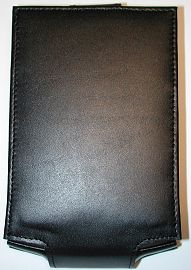
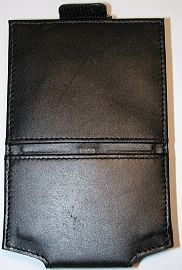
| Official
Gadgeteer Hands On Review: Q-Pad Keyboard
/ Case by Julie Strietelmeier Last date revised: 06/03/2002 |
Product Requirements:
Device:
Palm V/Vx, Handspring Visor Edge
8K keyboard.prc
The Q-Pad from tDevice is an interesting meld of a PDA case with PDA keyboard. Similar in concept to the Fellowes Type 'N Go Keyboard that I reviewed not long ago, this device is more compact and less expensive. There are two versions of this product available. A Palm V/Vx version as well as a Handspring Visor Edge version. Unfortunately, there isn't a version for the Palm m500 series... I was sent the Palm V/Vx version to review.


Constructed of black leather with a hard plastic keyboard and plastic dock, the Q-Pad looks professional and feels sturdy. It actually protects the PDA pretty well due to the fact that both the back and front are very rigid. However, both the sides and top of the PDA are exposed.

The Q-Pad actually adds very little to the size and weight of the Palm V/Vx.
Size Closed: 3.1 x 5.1 x 1.1 in (80 x 129 x 22.5 mm)
Size Open: 3.1 x 10.5 x 0.66 in (80 x 260 x 5 mm)
Weight with Palm Vx: 7.7 oz (219g)
Weight without Palm Vx: 3.5 oz (96g)
The back of this device is a molded black plastic dock which has a leather backing attached to it. The dock has a serial connector which mates with the serial/hotsync connector on the Palm Vx. To secure the PDA in the dock, a spring loaded metal tab is inserted into the slot on the back of the Palm Vx. To attach the PDA, you seat it on the connector and press it onto the metal tab till it clicks in place. Once done, the fit is quite secure.
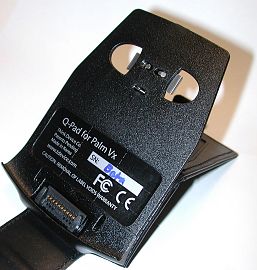
The cover portion of the Q-Pad also houses the keyboard in a 2.5 x 3.25 inch square which is framed in leather. The cover is very rigid and barely flexes when twisted. It is attached to the back part of the case via a 1.5 in flexible leather strip which probably has a thin ribbon cable running thru it (this is just a guess).
Unless you sync via IR, you'll need to remove the PDA from the Q-Pad to sync / charge with a cradle or cable.
The cover is held closed with a Velcro strip at the top of the PDA. I think it would have been much nicer had a snap been used instead, but oh well...
The keyboard has 60 individual small soft rubber keys. There is a separate numeric keypad and separate directional arrow keys. The alphabet keys are arranged in a standard QWERTY layout. There are even two keys that let you move to the previous and next fields. These two keys are labeled AE which doesn't make any sense to me, but they work, so that's all that matters right? All of the keys give you some tactile feedback, but there isn't a definite 'click' when you press them.
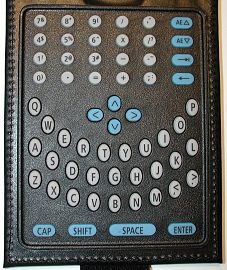
Of course, this isn't a keyboard that you will 'touch type' on. You will only be able to use one finger to press the keys. This isn't even a thumb style keyboard due to the fact that if you held it in between both of your hands, the PDA would flop backwards. There are two ways to use this keyboard. One way is to hold the PDA portion in one hand while you hold the keyboard portion in the palm of the other hand and use that thumb to tap out the keys. The more convenient way to use the Q-Pad is to set it on your desktop. The leather back plane of the case has a metal hinge in the middle which allows it to fold down to create a desktop stand.
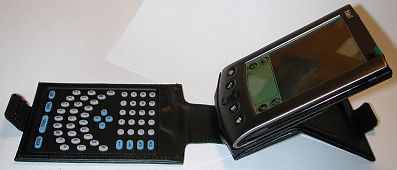
Before you can even use the keyboard as an input device to your Palm PDA, you'll need to install a small driver. This program allows you to enable / disable the keyboard, enable / disable audible key clicks, adjust the keyrate repeat, and adjust the delay until repeat rate. Once installed, and enabled, you can use the Q-Pad to enter memos, contact entries, appointments, etc. Unfortunately, the driver must be disabled manually when you want to beam data and hotsync.
The Q-Pad does not require its own batteries. It uses the power from the PDA. The Palm V/Vx will typically use about 10% more battery power when the Q-Pad is connected to your PDA than without the Q-Pad. Specifically, the Q-Pad for Palm Vx uses 650uA during keyboard operation, 22uA during sleep mode and 0uA when turned off.

For everyday use, I found the Q-Pad to be nice, but not extremely useful to me personally. I can actually enter text much faster using graffiti. That said, I know there are many people out there that do not like graffiti and would prefer a small keyboard like this one. I think the Q-Pad is most suited for people that both don't like graffiti, and also do not actually touch type. For those people, the Q-Pad is a great option as it is both compact and useful. Since it doubles as a PDA case, it's always with you and ready to go when needed. But it doesn't get in they way when you don't need it, like most snap-on thumb style keyboards. However, for those of you that are touch typists, I still recommend the Stowaway keyboard as the fastest data input device available.
The Q-Pad is the best implementation of a case / keyboard combo that I've seen to date. If this style of input device appeals to you, the Q-Pad is a quality device that should serve you well.
Price: $69.99
Pros:
Compact
Doubles as a protective case
Easy to use
Cons:
Must manually disable driver to beam and sync
Works best when used on a flat surface
No m500 series version available
| Let me know your comments
on the Q-Pad Keyboard / Case and read what others have to say. Back to Main Page. |